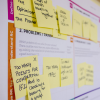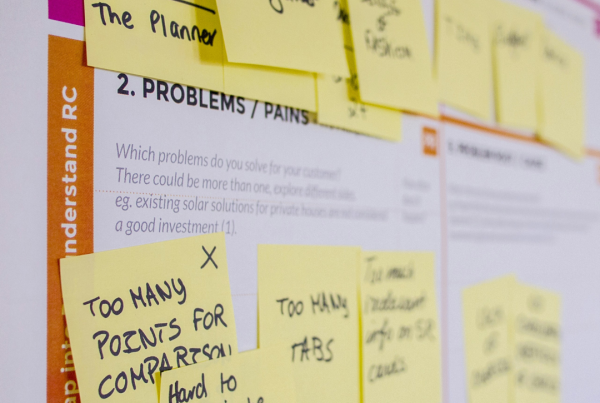When I speak with potential clients for the first time, I enjoy the process of understanding their problems thoroughly. Sometimes, they might describe their digital project in terms of what they want it to do or the features it should have. And I always find this situation a bit like putting the horse before the cart. It’s hard to build anything valuable without understanding the problem you are trying to fix.
Mindset is important when you’re approaching any project. You want to start with the mindset of finding the best solution to make your customers’ lives better. This may not necessarily be about keeping up with your competitors by releasing similar features or jumping on to the next bandwagon trend in your industry.
Design thinking forces you to think about the problem you’re trying to solve, not what your competitors are trying to solve. If you apply this principle vigorously, you will create useful products, eventually. So, what is the difference between outcome-focused and output or feature-focused?
Outcome is what you want to achieve for your customers, while output is the product itself such as features, themes, and function. Outcome is the end while output is the means to reach the end. When you’re striving towards an outcome, the means to get there can take on many forms or pathways. In project lingo, we also have what we call benefits. A benefit is a measurable result from the output that helps shape the outcome.

Example of an outcome-based project
Outcome-focused vs. feature-focused
In product management, it is more beneficial to focus on the outcome, not the output. You need to shift your mentality to measure your products based on real-word user benefits, not the number of features you release. And this principle should flow down to the product roadmap, agile sprints, and team organisation.
But why should you be outcome-focused?
1. You create a product with features that users actually use
Some companies, unfortunately, do get feature obsessed. It’s easy to see why. Features, or output, is easier to measure than outcomes. It makes resourcing and staffing easier, and creates a pretty powerpoint to show off in meetings.
There’s also a pressure to keep producing as a way to measure productivity. As soon as one project finishes, it’s on to the next one without any thought or reflection on what will help your customers. And pretty soon, you will have a bloated product that’s slow, inefficient and confuses the hell out of your users. When you focus on outcomes, you may end up having fewer features but you’ll also be more likely to receive higher use rates and user satisfaction.
2. You can easily turn users to advocates
The happier your customers are with your product and service, the more likely they will turn into fans. It costs less to market to existing happy customers than to acquire new ones. The more years they stay as your customers, the easier it is to grow your bottom line. And they, in turn, become advocates of your brand to their friends and families.
3. You minimise the risk you’re taking
The features you design may not necessarily solve a problem or make life easier for your users. But if you design an outcome for your users, they are more likely to benefit from them. There is a subtle difference between the two.
By designing solutions that focus on benefits, you will lower the risk of market rejection. You’ll more likely create products that meet a market need, rather than just another run of the mill product. Most businesses fail because they created a product that didn’t meet market needs.
4. It’s easier to get team buy-in
Your team is a major factor in your product’s success. And if you want to get buy-in and motivate them, focusing on outcomes is a better way. Instead of churning out features, team members start sharing the responsibility to solve user issues, design solutions and reap the satisfaction of seeing the impact of their work. Instead of working mindlessly towards go-live dates, they are working relentlessly to make an impact. It’s much easier to get motivated and dedicated people this way.
Tips on shifting towards an outcome-focused team
When it comes to transformations, it’s never going to happen within a short period. You’ll find culture and people are harder to change than technology, tools, and processes. Still, here are a few tips to get started on outcome-based organisation.
- Ensure you completely understand the user issues in hand. If you need to, get people back to the drawing board and ask, “What are the main problems we are trying to solve for our customers?”
- Product managers and designers no longer need to plan based on features to implement. Rather, it should be an outcome you want to see. The same goes to roadmaps and milestones. Rather than listing milestones such as, “Launch XYZ feature by Q2”, it’s going to be a measurable benefit such as, “Decrease user churn rate by 5%”
- Outcome-based projects need to have a strong customer feedback loop, because you will be iterating based on market feedback to get the results you want. The process is a lot like design thinking and agile development.
- Measure correctly and consistently. You’ll need to set the customer and business metrics, measure and track them with every iteration that you release. This is why customer feedback is vital.
- When you focus on outcome, milestones and deadlines are a bit trickier. Why? Because it is harder to know how many iterations and releases you will need to get the desired outcome. It could happen in 1 release or several releases to your customers. Find the most impactful outcome, and the most profitable, and start with that.
- Rethink your solutions. Sometimes, the only thing you need to do to get a desired outcome is simpler than you think. For example, improving your users’ onboarding experience could increase customer retention better, instead of a new fancy feature that’s costlier to develop and market.







